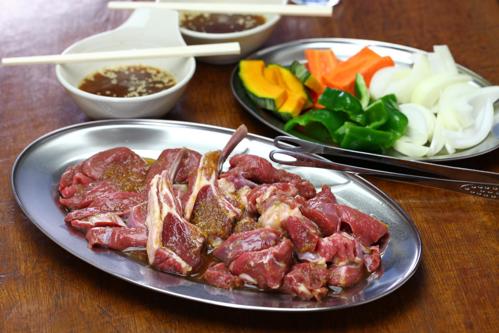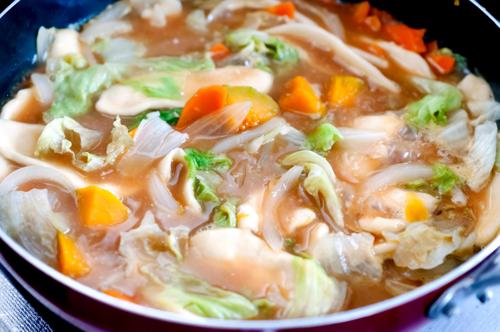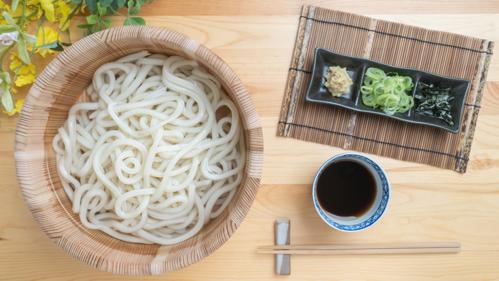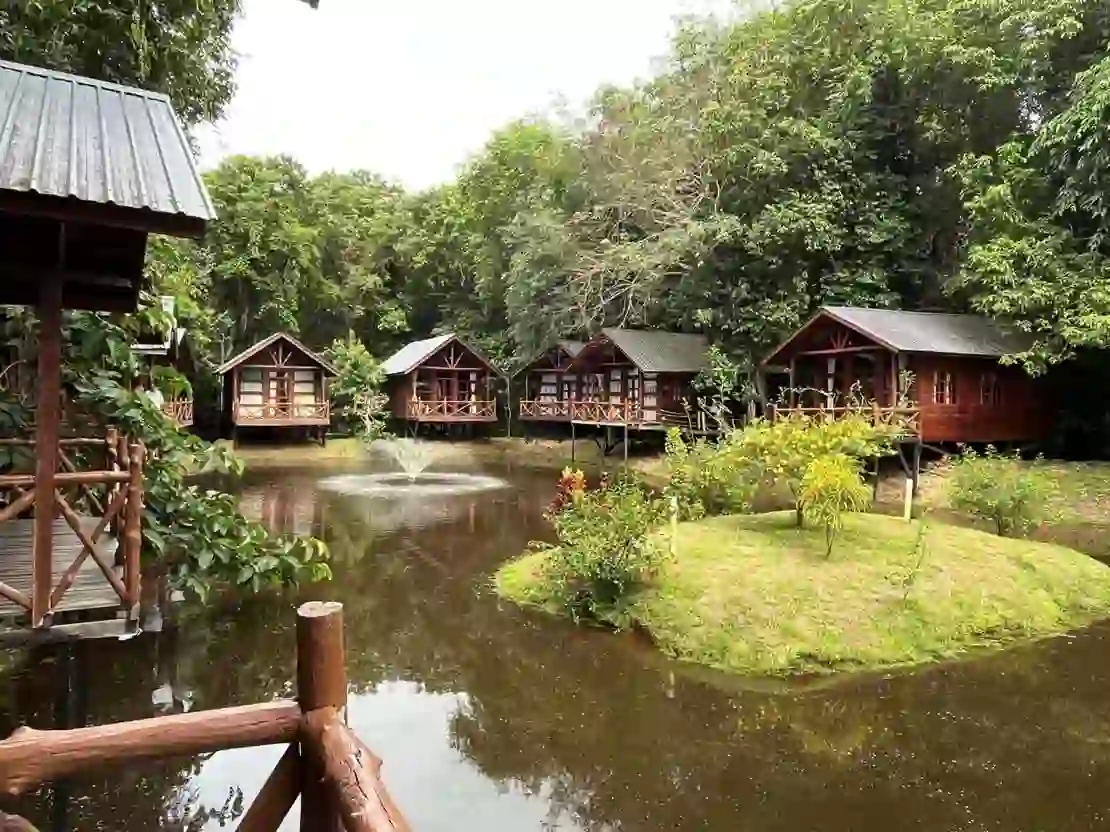
A localised guide to Japanese food
With the most Michelin-starred restaurants of any country, Japan is justifiably the food capital of the world. Many restaurants specialise in a single type of dish, so you can be sure of one thing – the signature dish on your order will be prepared to perfection. But this doesn’t mean Japanese cuisine is small or limited, in fact, it offers a wealth of gastronomical pleasures with an endless variety of regional and seasonal dishes.
Refined and elegant, traditional food in Japan celebrates and highlights simplicity, fresh produce and pure flavours. Where possible, food is eaten in as natural a state as possible and as fresh as possible – making raw fish or sashimi a quintessentially Japanese delicacy. Rice is also a staple in Japanese gastronomy, often steamed and served with main or side dishes.
Although the Japanese have honed the preparation and presentation of their traditional foods for centuries, they too have taken inspiration from other countries. Ramen and gyozas are staples, inspired from their neighbouring country, China. Taste the variety of flavours and textures of sushi and sashimi, enjoy delicate tempura deep-fried in light batter or slurp down steaming bowls of ramen. Whatever pleases your taste buds, you won’t be too far away from a great meal, especially on our Japan tour.
Each region of the country has its own delicacies and culinary traditions, drawn from the local culture and ecology. With this in mind, we've put together this guide to traditional Japanese food based on the country's eight regions. Without further ado, let's tuck in to the best dishes in each part of the country.
Kansai
Also known as Kinki, this region encompasses a large area of central Honshu, Japan's largest island. It is home to the popular cities of Kyoto, Osaka and Nara, as well as spectacular scenery. Kansai also boasts the world-famous Kobe beef, renowned for its superior flavour and tenderness.
Yudofu - Something of a staple in Japanese cuisine, tofu is eaten in various dishes throughout the country. The Kansai region takes this to another level, though. In Kyoto, the specialty is boiled tofu. This simple delicacy is made using only three ingredients; silken tofu, seaweed and water, and is cooked in a hot pot. It is usually served with soy sauce and broth.
Funazushi - This is a type of nare-zushi, or salted raw fish, that hails from Shiga Prefecture. Crucian carp is usually the fish of choice, which is pickled and marinated for around six months. The fish is served whole or cut into thin slices, and is sometimes eaten as a snack. Dating back to ancient times, the dish is often enjoyed at festivals such as New Year's. It is also believed to help alleviate stomach aches in parts of the region.
Takoyaki - A much-loved street food in Japan, takoyaki hails from Osaka. It is made by mixing cubed octopus, ginger and green onion and frying it in a batter. Often cooked in a special pan with round moulds, the dumplings have a distinct spherical shape. They are usually topped with okonomiyaki sauce (similar to Worcestershire sauce) or Japanese mayonnaise, and sprinkled with bonito flakes and pickled ginger.

Hokkaido
As Japan's northernmost island, Hokkaido's cuisine has been formed by its colder climate and rural landscapes. The region is renowned for its seafood and dairy products, and for its excellent ramen. If you're travelling to this part of Japan, food specialities to look out for include:
Jingisukan - this local delicacy consists of grilled mutton or lamb cooked on a skillet. Tender and flavourful, it is usually served with grilled peppers, mushrooms and beansprouts and a soy sauce or sake-based dipping sauce. The translation of the dish's name is 'Genghis Khan', and is thought to have been given due to its inspiration drawn from the mutton dishes of Northeastern China. The first recorded mention of the dish was in 1931, and it is still a much-loved favourite today.

Soup curry - Given its relatively colder climate, it's perhaps not surprising that Hokkaido is home to a wide variety of warming hot pot and soup dishes. One particular favourite is soup curry, which hails from the city of Sapporo, the island's capital. Its ingredients include chicken, potatoes, mushrooms, carrots, and lotus root. Its sauce is much thinner than traditional Japanese style curry, resulting in a chunky soup that is usually served with rice.
Tohoku
Located on Japan's Honshu island, Tohoku is perhaps best known for its volcanoes and rugged landscapes. The region's cuisine relies heavily on fish and seafood, with tuna and salmon being particular favourites. Look out for these delicacies on the local menus…
Hittsumi - One of the most popular dishes in Japan's Tohoku region is hittsumi. This soup is usually made with chicken, flat wheat noodles and vegetables, with specific recipes varying between areas and households. The dish was originally developed as an alternative to rice-based dishes for periods when the rice harvest was bad due to cold weather. Today, it is enjoyed year-round in the region, and is also often served at special events.

Wanko soba - Originating from Iwate Prefecture, this dish offers the chance to enjoy a meal with added thrills. During the meal, soba noodles are served in small portions in individual bowls. Every time you finish a bowl, a server immediately refills the bowl, and will sometimes offer encouraging chants. Condiments such as tuna sashimi, nameko mushrooms, minced pork and seaweed are offered alongside the noodles.
Chubu
Chubu encompasses central Japan and is located on the country's most populated island of Honshu. Home to the impressive peaks of Mount Fuji and the Japanese Alps, the region attracts adventure and nature lovers alike. Here is our pick of the region's best traditional dishes:
Hoto - If you're looking for vegetarian food in Japan, hoto is a great choice. This warming dish consists of extremely thick udon noodles and seasonal vegetables in a miso soup. The thick noodles are almost dumpling-like in their consistency, making the dish more filling. Perhaps this is why it is said that it was once eaten by samurai before going into battle.
Kanazawa Curry - Curry is undoubtedly a popular food in Japan, and Kanazawa's version is no exception. Thicker than usual Japanese curry and dark in colour, it is typically served alongside a breaded deep fried pork fillet with ample rice and shredded cabbage.
Hoba miso - Created in the city of Takayama, this dish is formed of grilled meat and vegetables served on a dried magnolia leaf and finished with a topping of miso paste. While traditionally eaten with rice, nowadays it is served with a variety of accompaniments including fish and beef.
Chugoku
The Chugoku region is home to the major tourist city of Hiroshima, as well as other popular cities like Fukuyama and Kure. The region is home to fascinating history and natural beauty, and its cuisine is diverse and flavourful. Here are a few of the traditional dishes you can expect to find on local menus.
Okonomiyaki - If you are concerned about the cost of food in Japan, you'll be pleased to know that there is an abundance of cheap and tasty street food to sample throughout the country. One of the best examples is okonomiyaki. This fried savoury pancake with pork and cabbage filling and yakitori, is the nation’s kebab equivalent – and generally enjoyed with a beer or two. The Hiroshima version is unique as the ingredients are layered instead of being mixed together.

Hiroshima oysters - Hiroshima Prefecture is also known for its high-quality oysters. Large and rich in flavour, the oysters have a distinct taste and can be enjoyed raw, grilled, deep fried or as part of a hot pot. Oyster season generally runs from January to February, but this local favourite can be enjoyed all year round in Hiroshima.
Barazushi - this dish dates back to the Edo period, when it was created as a way to enjoy fish, rice and vegetables together at a time when only "one soup and one side dish" were allowed at each meal due to austerity. This sushi bowl consists of raw fish, rice, carrot, mushrooms, egg and lotus root.
Kanto
Kanto is an incredibly diverse region, being home to bustling metropolises, including the country's capital, mountains and forests. The region lays claim to several of the most famous Japanese food exports, including sushi and tempura, and there are plenty of other equally delicious, lesser-known dishes to sample here.
Monjayaki - This is a pan-fried batter that originated in the Tsukishima neighbourhood of Tokyo. It is similar to the aforementioned okonomiyaki, but has a texture more like melted cheese. Ingredients include eggs, flour, cabbage and various meat and vegetable options. It is usually eaten straight off the grill using a spatula, alongside condiments such as soy sauce, mayonnaise and onions.
Kuro-tamago - If you are travelling to Hakone, don't miss the opportunity to try this enduring local delicacy. Kuro-tamago are chicken eggs boiled in the hot springs of Owakudani. As the eggs are cooked in the 80°C water, iron reacts with hydrogen sulphide and turns them black. According to local folklore, eating one of these eggs can extend your life by seven years.
Yaki imo - This simple snack is just baked satsumaimo, or Japanese sweet potatoes. The cooked potato is wonderfully sweet and flavourful, negating the need for any seasoning or condiments. Yaki imo can be found throughout Japan, but it is particularly loved in Tokyo, where they are sold in convenience stores and there is even an annual festival devoted to it.
Shikoku
Despite being the smallest of Japan's four main islands, Shikoku boasts a wealth of unique dishes and traditions. Its proximity to the Seto Inland Sea provides it with a wide variety of fresh seafood, including oysters, octopus and an array of fish. Here are a couple of the region's most beloved dishes:
Katsuo no tataki - There are many ways to eat fish and seafood in Japan, and the Shikoku region has many of its own specialities, with sashimi and seafood tempura both popular. A particular favourite is Katsuo no tataki. Usually served at casual izakaya eateries, this dish consists of finely sliced skipjack tuna that is lightly seared and served with a citrus-based sauce.
Sanuki udon - The Kagawa Prefecture is famous for its udon (noodles made from wheat flour), in fact, it is affectionately known as the 'Udon Kingdom'. The most popular type is Sanuki udon, a thick and chewy noodle that is often served in broth and topped with egg, green onions and tempura.

Kyushu
Kyushu is Japan's third-largest island. It enjoys a subtropical climate and is home to the port city of Fukuoka and Nagasaki, which was devastated by an atomic bomb in 1945. The region boasts diverse culinary offerings, with dishes in the north being predominantly seafood-based, and those in the south largely focusing on meat.
Saga Wagyu beef - When it comes to premium meats, the food price in Japan can become eye-wateringly expensive. The country is home to a number of Wagyu beef varieties, and in the Kyushu region it is Saga beef, hailing from the prefecture of the same name, that is most renowned. Saga cattle live a life of luxury, resulting in tender and well-marbled beef that is usually served simply as a steak or as part of shabu shabu.

Mizutaki - This hotpot dish is especially popular in the region's Fukuoka Prefecture. It consists of chicken, tofu, and vegetables such as bok choy, carrots, and mushrooms, gently cooked in a dashi broth, and makes for a warming way to refuel during winter sightseeing trips.
So that was our run down of some of the most popular Japanese dishes. In Japan, food can vary greatly from region to region, with ingredients and culture playing a big part in the local cuisine. Traditionally, Japanese dishes are heavily influenced by the changing seasons, ensuring the freshest ingredients are used in every meal. Whichever part of the country you visit and whatever the time of year, you can be sure of distinct flavours and unique specialities.
Ready to embark on a food tour of Japan? Our escorted tour has been expertly crafted to cover the country's most spectacular sights.
Visit Japan
- Partake in a traditional Japanese tea ceremony, an ancient and spiritual practice
- Journey to the sacred eight natural springs and traditional thatched houses of Oshino and Lake Kawaguchi
- Immerse yourself in the energy of Japan’s electrifying capital, Tokyo, on a guided tour
- Flights included
16 days from £4,944 pp
was £6,179 pp
Dates Available
March 2026 - November 2028
Duration
16 days
Depart From
5 airports
Excursions & Visits
11 included
Meals
16 included
- Immerse yourself in the energy of Japan’s electrifying capital with excursions to Tokyo Skytree and Shibuya
- Ride a bullet train to Kyoto and uncover its medieval landmarks and Geisha district
- Explore Kyushu’s historic craft industries with guided tours of Fukuoka, Dazaifu and an Imari pottery factory
- Flights included
16 days from £5,457 pp
was £6,419 pp
Dates Available
October 2026 - November 2027
Duration
16 days
Depart From
1 airport
Excursions & Visits
16 included
Meals
17 included
- Discover the culinary and cultural attractions of Seoul with visits to Changdeokgung Palace, Gwangjang Market and N Seoul Tower
- Visit coastal Busan’s historic landmarks, from Gamcheon Culture Village and Jagalchi Market to Busan Tower and BIFF Square
- Spend time in Beppu, the home of dramatic, colourful hot springs and visit the Hells of Beppu
- Flights included
18 days from £7,128 pp
was £8,385 pp
Dates Available
18 March 2026
Duration
18 days
Depart From
3 airports
Excursions & Visits
13 included
Meals
22 included
Discover our blog
Six things to do in Bangkok
If you want a tropical city break with plenty of culture, tasty cuisine and shopping opportunities, then Bangkok is the perfect travel destination.
Four things to do once you land in Luang Prabang, Laos
Luang Prabang things to do: Discover the best things to see and do in Laos' charming city. Read our blog and book your trip with Newmarket Holidays.
Staff Stories: The rainforests and orangutans of Borneo
Uncover the lush forests and rare primates of the beautiful island of Borneo.





